*Sharing is the most powerful tool we have to make a message heard; if you find this article useful i ask you to please share it, talk about it in an instagram story and tag me at @saramelotti_ or share this link on your facebook and twitter. You’ll find a video version of this article on my instagtam.
How many times have we felt ugly? Inadequate? Too fat? Too skinny? Not good enough? How many times have we talked shit about our bodies? How often have we suffered because we think we are not enough the way we are? But, above all, how many times have we thought that this feeling of being inadequate is all our fault?
The good news is that this is not our fault, but of a society that, for more than half a century, keeps doing its best to make us feel as we are not ‘right’ the way we are, by producing beauty standards that are impossible to achieve and that create insecurities; insecurities that make a ton of money to several industries.
The bad news is that these standards are so ingrained into our psyche that it ‘s hard to see things as they really are. Through this article, I hope I’ll be able to give you some tools you can use to get rid of that feeling of inadequacy or at least to see things under a different light. Maybe you already know all this, but since there have been no significant changes yet, maybe, just maybe, I need to refresh your mind.
* In this article I mainly speak to women, but I would also like men to read and participate to this conversation.
“I wish I could photoshop my face even in real life!”
That’s how I started my path towards awareness.
I was 27 at that time and I was a fashion photographer in NYC. It was an afternoon like many others, I was getting ready to go out, and as i looked in the mirror I caught myself thinking that sentence. That’s when I realized I had a problem.
For months I’d been looking in the mirror on the verge of tears , I saw a monster reflected in there, I hated my face and my body. From that  day on I began to notice that my friends were also constantly complaining about their bodies; the recurring mantras: “I’m fat” “I’m a fucking whale”, “my thighs are huge”, “my skin is horrible” “I want to get a nose job” – shit, wanted to get a nose job too, I was 100% sure I needed it– “I hate my face”, and the inevitable “I’m disgusting”.
day on I began to notice that my friends were also constantly complaining about their bodies; the recurring mantras: “I’m fat” “I’m a fucking whale”, “my thighs are huge”, “my skin is horrible” “I want to get a nose job” – shit, wanted to get a nose job too, I was 100% sure I needed it– “I hate my face”, and the inevitable “I’m disgusting”.
Then, one day I was on set, I was shooting a test for a model agency, the model was 14 yo– Russian, blonde, tall, skinny –and, out of the blue, without me asking her for it, she started making these super sexy and provocative poses, too sexy and provocative for her age, and as I looked at her looking into my lens as if she wanted to fuck it, I felt a “crack” inside and I heard a voice coming from somewhere deep within my conscience screaming:
WHAT THE FUCK ARE YOU DOING?
From then on, nothing about my job made sense anymore. It would have taken me months of research for me to get there, but I would have realized that images are powerful tools and if used in the wrong way they can have devastating consequences.
With my work and the kind of images I used to make, I was contributing to create very unrealistic, unachievable and self-esteem-killer beauty standards—and it’s no news that when our self-esteem is low, it’s difficult to reach your goals and fulfill ourselves – that perpetuate gender inequality. I was also contributing to feed a hellish machine purposely designed to make us feel like shit, to make us think that the way we look is more important than who we are, to ultimately distract us from our own capabilities and potential to turn us into perfect consumers.
Men are affected by this too, but women remain, without a doubt, the ultimate victims of these toxic dynamics. These afre not conspiracy theories, but undeniable truths that lie right before our eyes on a daily basis, but that often we are not able to see. I think it’s time to shed light on them!
1- THE BEAUTY MYTH – HOW STANDARDS THAT KILL SELF- ESTEEM ARE CREATED
Tall, skinny, smooth and even skin, young, white. A rather limited idea of beauty that represents an extremely low percentage of the world’s female population. Yet this is the beauty standard that most women are chasing nowadays.
But it hasn’t always been that way. You just have to take a glance at this picture to realize that beauty standards were very different in the past: having a plump and curvy body had never been an issue before the Sixties.
 How did we get to the point of thinking we have to look like the models in the last picture? Everything began, more or less, a century ago, during the First World War. As men were busy at the front, women found themselves in charge of duties that were previously reserved to men, which allowed them to reach more independence, especially economically-wise. The Patriarchy didn’t really like this new independence though, so it found a great way to make women spend that extra cash they were saving by putting in their head the idea that their body was a problem, and that they needed to spend their time and money to ‘fix it’. How did they do this? Through the media and advertisements.
How did we get to the point of thinking we have to look like the models in the last picture? Everything began, more or less, a century ago, during the First World War. As men were busy at the front, women found themselves in charge of duties that were previously reserved to men, which allowed them to reach more independence, especially economically-wise. The Patriarchy didn’t really like this new independence though, so it found a great way to make women spend that extra cash they were saving by putting in their head the idea that their body was a problem, and that they needed to spend their time and money to ‘fix it’. How did they do this? Through the media and advertisements.
The advertising industry [that after the War completely changed the way they advertised, going from an ‘informative model’—that advertised products people needed by describing their utility—to a ‘consumerist model’—that pushed citizens to buy and consume more and more, especially goods that he/she did not need but that would ‘elevate’ their social status—by going straight to their subconscious (fear, desires and insecurities) through slogans and pictures] aimed at creating a product that they would have been able to sell forever. They wanted to create a problem for which they could sell the solution to in perpetuity, and the female body turned out to be the ideal problem! So, they started telling us what was wrong with our bodies and what we should do to fix them, and then—coincidence?—they had a product ready to sell to help us fix it.
The perfect example that confirms this theory is cellulite.
About 90% of women in the world has cellulite, until the Sixties it was not a problem at all: cellulite was normal, it was just considered ‘flesh’, it didn’t even have a name. In fact, the word ‘cellulite’ appeared for the first time in an article on Vogue magazine in 1968, where the magazine described it as a ‘disfiguring feature’. As soon as that edition of Vogue was distributed, the myth of cellulite became mainstream and suddenly women started to think that those holes and little bumps that they saw on their skin were a disfiguring flaw that had to be eliminated at all costs. Of course, Vogue also offered some ‘cures’ to this horrible ‘condition’ that had just been invented: among them were also the expensive treatments offered by Nicole Ronsard’s Beauty Salon. During the Seventies, Nicole Ronsard wrote several books about cellulite… which made her a millionaire.
 And there you go, suddenly we start seeing ads for hundreds of products and treatments against cellulite popping up like mushrooms: creams, devices, massages, diets, medicines, supplements, muds. Every woman fell for it, but in truth, cellulite has neither a cause nor a precise cure —you just have to google “remedies against cellulite” and open 2-3 different websites to understand that they are blatantly fucking with us—and none of those miraculous products that they’ve been bombarding us with really works. No wonder that in the US, brands such as L’Occitane, QVC, Nivea and many others got sued by the FTC (Federal Trade Commission) for “false and misleading advertisements”. In a nutshell, there is no ‘real cure’ against cellulite because there is nothing to cure, if not a natural human condition that was strategically turned into a female disease.
And there you go, suddenly we start seeing ads for hundreds of products and treatments against cellulite popping up like mushrooms: creams, devices, massages, diets, medicines, supplements, muds. Every woman fell for it, but in truth, cellulite has neither a cause nor a precise cure —you just have to google “remedies against cellulite” and open 2-3 different websites to understand that they are blatantly fucking with us—and none of those miraculous products that they’ve been bombarding us with really works. No wonder that in the US, brands such as L’Occitane, QVC, Nivea and many others got sued by the FTC (Federal Trade Commission) for “false and misleading advertisements”. In a nutshell, there is no ‘real cure’ against cellulite because there is nothing to cure, if not a natural human condition that was strategically turned into a female disease.
After that, thousands of articles appeared on magazines all over the world (and later also on TV and online) that, apart from cellulite, told women that either this or that other part of their body was not okay the way it was—like the thigh gap, a must-fucking-have!—with a particular focus on thinness, that year by year would become more and more extreme. This toxic loop continues to kill our self-esteem today, and its only purpose is to enrich the beauty/fashion/plastic surgery/diet and advertising industries. Industries that create and feed on our insecurities, by raising the bar a little bit higher every day, towards heights that we will never be able to reach.
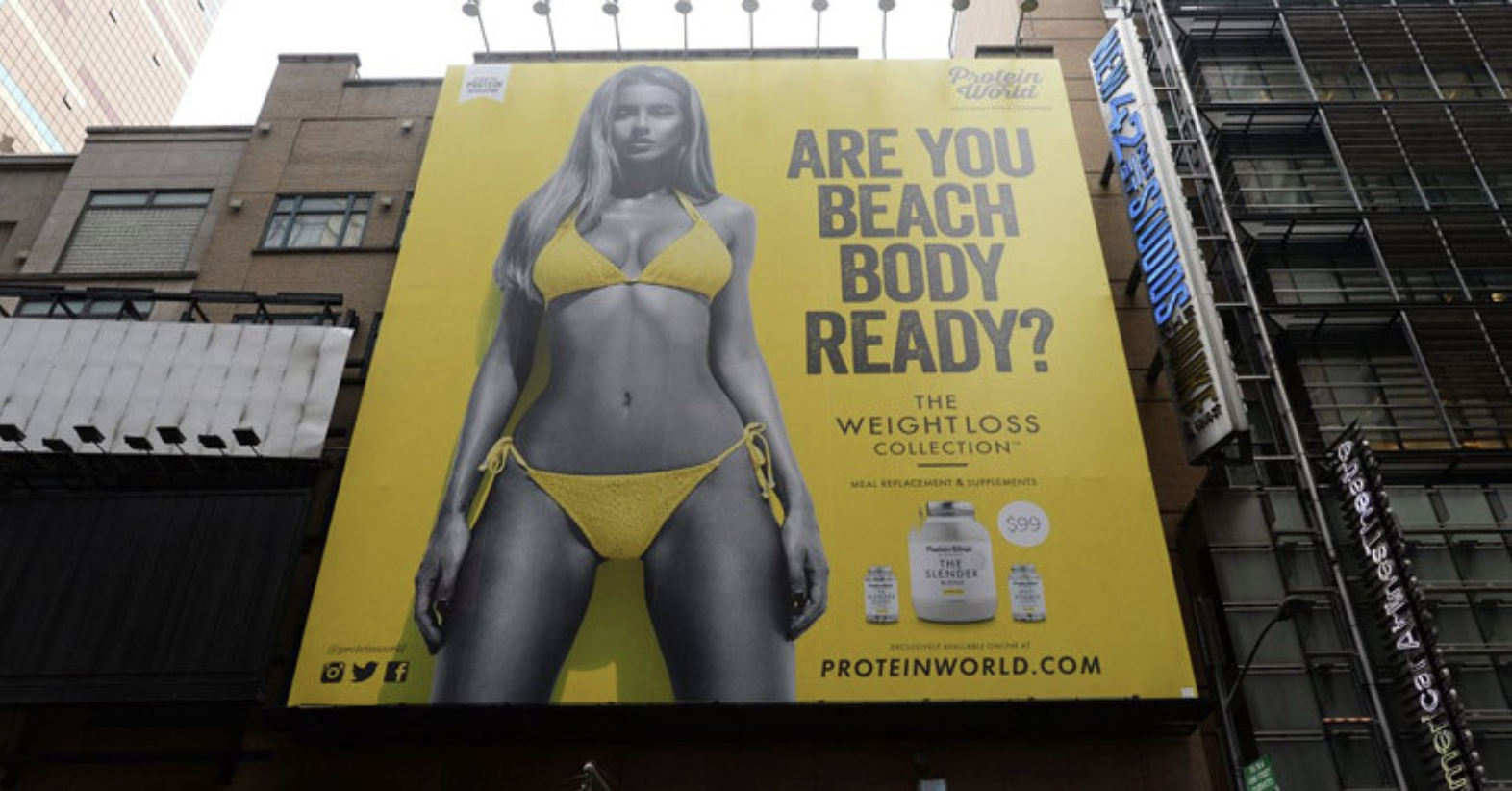
2- THE INDUSTRY OF INSECURITY AND THE POWER OF IMAGES
Never as much as today the world has been so full of images. Pictures are everywhere; just by leaving your home, without us even noticing it, we keep absorbing images—on advertising billboards around the city, in store windows, on busses, etc—then we have the images on our screens—TV, social media, cinema— even if we don’t pay attention to them, all those images have a strong influence on our psyche: what we see influences how we see ourselves.
And if we are constantly bombarded by pictures representing ‘perfect’ women—women that fit into The Standard described earlier; a standard that does not represent the majority of us—it’s inevitable to see ourselves as imperfect and lacking; that way feeling comfortable in your own skin and with your appearance becomes a daily war; because the subliminal message that we end up interiorizing is this: “you’re wrong, your body is wrong! You are not ok the way you are” You have to be like them!”.
But we will never be like them, because those pictures are not real. Let me explain this…


ANATOMY OF AN IMAGE – THE GIRL IN THE PICTURE & WHY WE’LL NEVER LOOK LIKE HER
I worked on fashion sets for years; since I used to create those pictures, I do know a little bit about them. By now we all know that there are many people, many hours of work and much, much post-production involved behind editorial and commercial images, and that—9 out of 10 times—the women we see on magazines and on advertisements are professional models. These women—actually, on average we’re talking about girls between 14 and 20 years old—are being photographed mainly because they won a genetic lottery. What perhaps not everybody knows is that even though THIS is The Standard forced on us, less than 2% of the world’s female population has that type of body and face traits(rigorously symmetric).
And even THEY are not ok the way they are: obviously the pictures are always manipulated and heavily retouched. This is how it works: the model arrives on set, she spends a couple hours in hair & make up that make her look even more “perfect”, then she’s put on set where there’s whole team of professionals that makes sure that not a single hair is put of place, on set she poses under special lights that minimize any possible flaw. Then, once the shoot is over, there are hours of photoshop and post-production (and don’t think that videos are not subject to the same type of post-production: the skin gets “smoothed” so that pores and wrinkles are eliminated, bodies are slimmed down, etc).
So, at the end of the day the girl in the picture doesn’t even look like the girl in the picture yet we look at the girl in the picture and we torture ourselves because we don’t look like her. Why?
Because the-girl-in-the-picture is the only type of woman we see in the images that society constantly shove in our faces, because she is The Standard that they want us to aspire to.
 An unrealistic and unachievable standard for 98% of women in the world, that makes us perpetually dissatisfied with our own image. Unfair? Fuck yes it is:
An unrealistic and unachievable standard for 98% of women in the world, that makes us perpetually dissatisfied with our own image. Unfair? Fuck yes it is:
We are victims of a capitalist and consumer system created with the sole purpose of keeping us in that state of dissatisfaction and exploit the insecurities caused by it, because—as many other great women said before me—if tomorrow all the women in the world looked in the mirror and liked themselves, many, many companies would go bankrupt. Because happy women are terrible consumers!
LITTLE WOMEN BUY
Our trip towards insecurity-land begins when we are little girls. Since we’re little there’s a certain attention on our physical appearance, and the idea of having to be beautiful or pretty gets rooted in our mind. So while boys have fun running and rolling wherever they want, we are told that we should be careful to our clothes—which often are much less comfortable than boys’ clothes – that we should not get dirty because we have to ‘behave’ and look ‘like a little lady’. Then, we have all those Barbies, whose body is very, very similar—another coincidence?—to a model; and what about Disney Princesses? They’re all super beautiful, super thin etc. etc… so, by the time we become teenagers, we are filled with paranoias on our physical appearance, and while staring in the mirror we start facing our “never enough”.
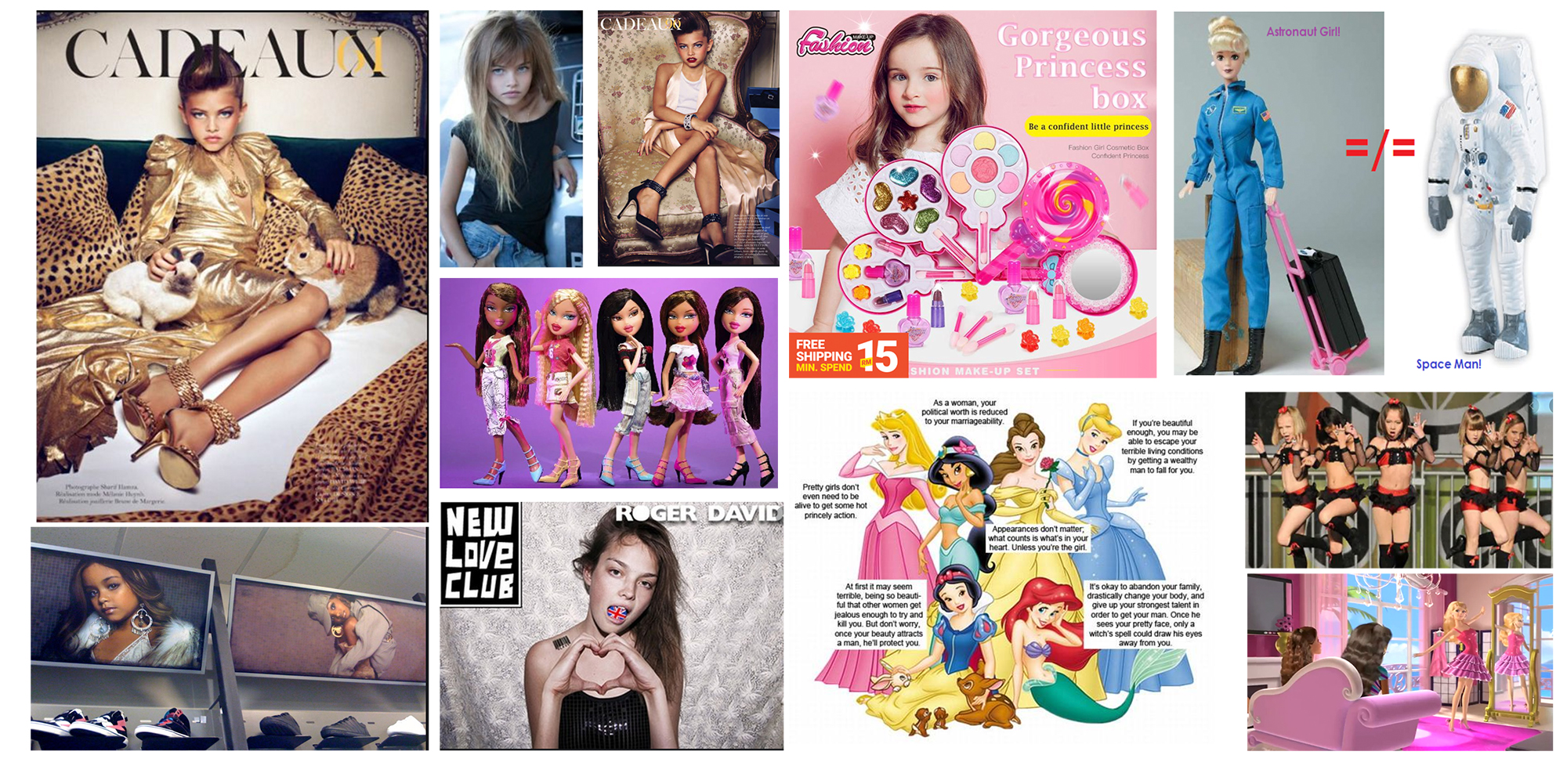
Mine and previous generations were actually pretty lucky: today’s little girls have to deal with much more idealized—and sexualized—images than the ones we grew up with. Also, they are subject to a ruthless marketing that aims to ‘fashion and beauty consumerism’. We all know that toys advertisements are bff with gender stereotypes: while little boys are targeted by toys representing strength, adventure and power, little girls are still bombarded with the same superficial bullshit focused on beauty and aesthetics: barbie fashionista; shopping Bratz dolls, make-up for kids and—horrible and scary new entry from the last decade—lingerie for little girls!
Advertisements, media and ethics don’t always travel on the same track…
THE ILLUSIONISTS – THE MEDIA: CENSORS OF NORMALITY, MANIPULATORS OF REALITY, CREATOR A OF AN IMAGE OBSESSED CULTURE
Elena Rossini – Italian director, producer, public speaker and also my personal role-model – explains what follows much better 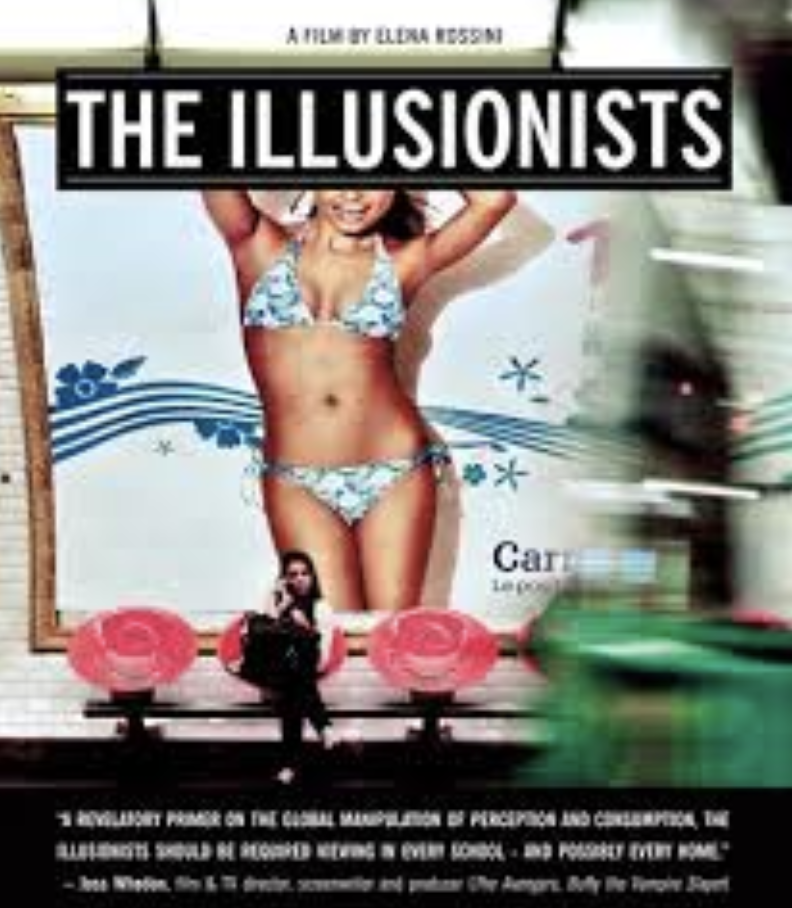 than I ever could in her documentary “The Illusionists” (a documentary that I strongly suggest to watch and that, in my opinion, is an important contribution to modern society and that should be watched in every school of this planet) the beauty standard is dictated, propagated and perpetuated by the media—whose survival entirely depends on advertisements—that for decades have acted as censors, doing a great job in blocking any image of “normal” women from getting in front of us; telling us that being thin is an imperative—and we are talking about unhealthily kind of thin, the kind that makes skinny girls feel fat thought they are already thin—basically they de-normalized normality.
than I ever could in her documentary “The Illusionists” (a documentary that I strongly suggest to watch and that, in my opinion, is an important contribution to modern society and that should be watched in every school of this planet) the beauty standard is dictated, propagated and perpetuated by the media—whose survival entirely depends on advertisements—that for decades have acted as censors, doing a great job in blocking any image of “normal” women from getting in front of us; telling us that being thin is an imperative—and we are talking about unhealthily kind of thin, the kind that makes skinny girls feel fat thought they are already thin—basically they de-normalized normality.
Only recently have we seen a gradual increase in the degree of diversity in the sizes represented by the media, and the fashion industry started showing more examples of “imperfect beauty”—vitiligo, albinism, strabism etc.—by using of models that stood out for unusual details—though their flaws are not celebrated but sensationalized, as if they were freaks—but overall there are still few images of “normal women”, and often pictures of plus-size models are still heavily post-produced (bye-bye cellulite!) and model’s faces remain the “perfect” and symmetrical familiar face we’ve seen a million times before.

A great example of “denormalization of normality” is the infamous body hair—eewww!gross!—Have you ever noticed that, in advertising of shaving products, the image we see is always that of a woman using the razor/cream/wax on legs and armpits that are already completely hairless?! They are shaving…nothingness! And there you go, the notion that body hair is unnatural gets rooted in our mind, while actually is just a natural part of being human. Fun fact: guess from where the idea that women should be completely hairless comes from? From the pornography industry!
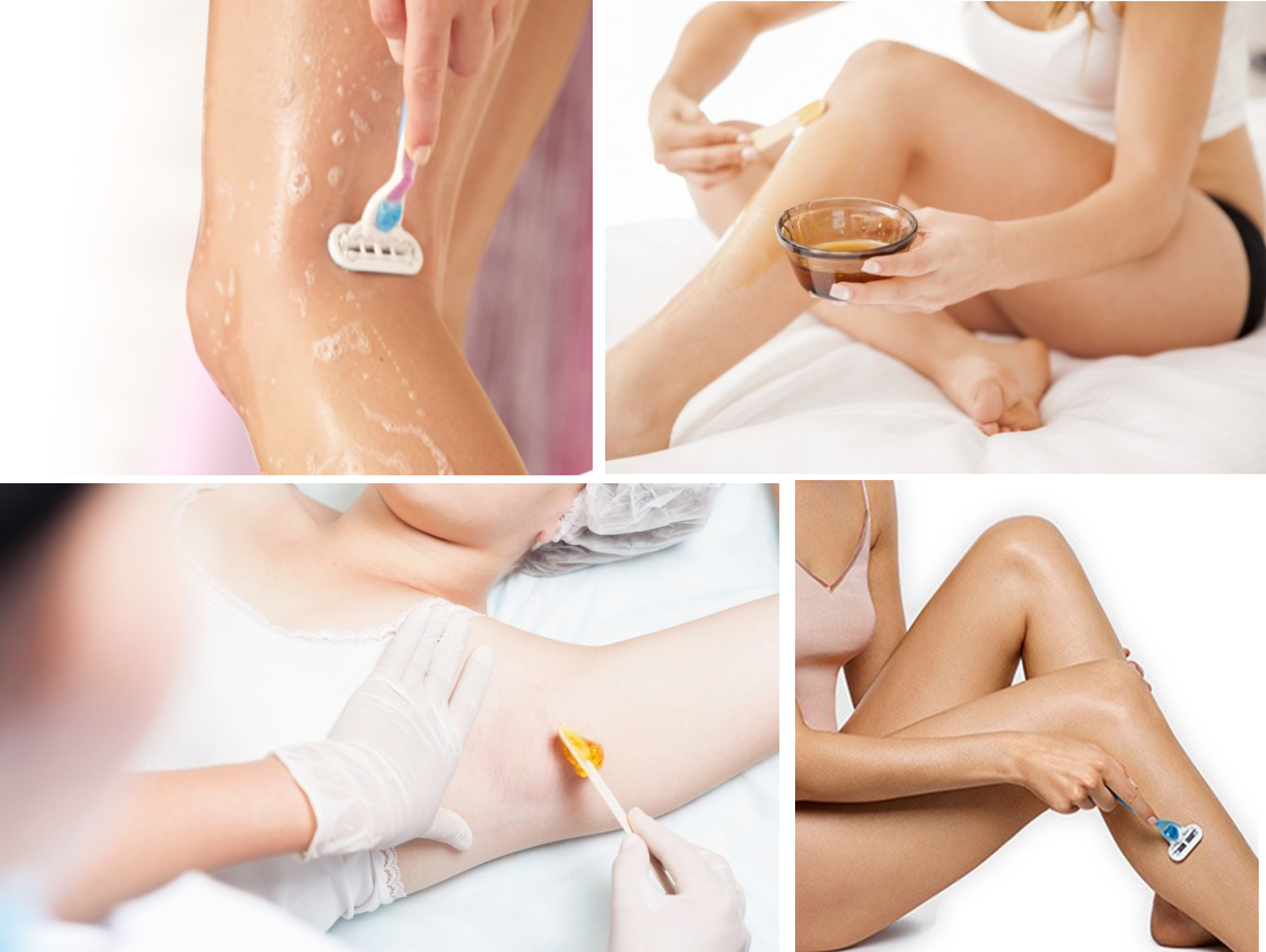
[A study conducted by the Royal Society shows that, if media increased the number of pictures showing either normal or overweight women, it would help to significantly reduce the feeling of dissatisfaction most women feel towards their body, and it would also contribute to reducing the rates of obesity and eating disorders. But obviously, media and advertisers tend to not giving a fuck about it, because it would be counter-productive for them.]
Once they take normal women out of the picture (literally), they—media and advertisers—bombards us with misleading, hyper-sexualised and hyper-photoshopped images. Even though we all know that most of the pictures we see are fake and constructed—even those posted on social media, both by influencers and by ‘normal’ girls and women are often heavily edited—our perception of reality gets distorted anyway. Why? Because very, very rarely we get to see the behind-the-scenes or the before & after of those photos.
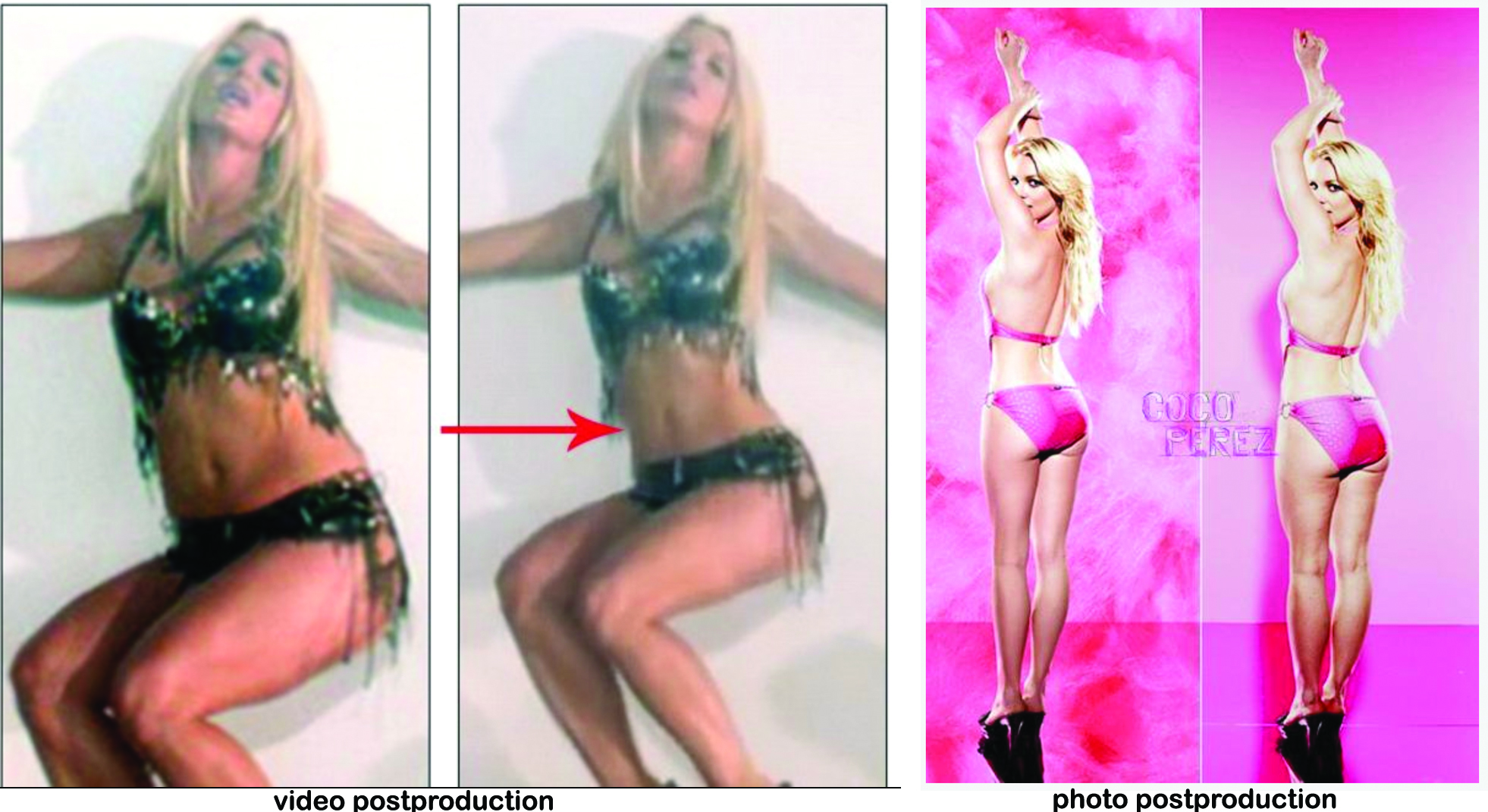
If cellulite is always hidden, having it will become an anomaly—despite it is actually the norm to have it—if we never see images of “normal women”, the unreachable standard will creep into our mind as real and common, and that’s how the toxic comparison trap starts: we start compare our bodies to those in the images and we automatically start feeling that ours is not right, not ok. The feeling of ‘inadequacy’ grows inside us and the “never enough” becomes part of our daily life.

Like Elena explains in “The Illusionists”: “after censorship and manipulation, comes saturation—which I call ‘the bombardment’—which means that all these deceptive images that represent unreal standards and idealized bodies are scattered EVERYWHERE; not by chance, are placed side by side to advertisements that tell us what we should buy to get that idealized appearance, giving us the illusion that that type of beauty can be bought. And we fall for it, filling our bathrooms with products that we don’t need—85% of expenditure on beauty products is made by women—convincing ourselves that aesthetics is an important—for some even fundamental—part of life.
Because the way media and advertisers use images is wicked: images of beauty are strategically associated to images of wealth, success, admiration, love and happiness. And these messages go straight to our subconscious. Beside telling us—actually more like imposing upon us—what beauty, femininity, masculinity and sexuality look like, between the lines, what they are really telling us id that to be happy, to be successful, to be loved, to have a better life, we need to be beautiful. Reminding us to exhaustion that to be beautiful though, we also need to be thin/skinny. How many of us have ever thought that being skinnier, having bigger boobs or a smaller nose would have improved our lives?!
beauty = thinness = happiness
The way the media distort the perception of our appearance changes our own perception of our value as people (and goodbye self-esteem!). And that’s how you create a culture obsessed with external appearance, which is fertile ground for body-shaming, objectification of women—that generates gender inequality—anxiety, depression and eating disorders (which, FYI, are exponentially growing all around the world, as is the number of women undergoing aesthetic surgeries) making us believe that our body is “a project we need to constantly work on”, until we’ll reach that unreachable standard. Doing so countless women die without having ever even liked themselves. I don’t want to be one of them; do you?
I don’t want to get you depressed, quite the opposite, I want to help you understand how to fight this unjust and sick system; at the end of this article I will share with you a few tips—that worked for me—but before this there are still a couple of very, very dark aspects of this self-esteem-killing-machine that we should all be familiar with, if we want to win the fight against the mirror. Brace yourselves!
WHITE PRIVILEGE AND GLOBALIZATION OF BEAUTY
Let’s recap: to be considered beautiful by modern society, you have to be skinny—muffin tops? Eeww!—forever young—older than 40? Wrinkles? omg the horror!—and, especially, you have to be WHITE. Yes you heard right: white!
Because guess what standard is imposed to Asian, African and South American women? The same that they impose to us! So, in addition to facing the pressure to be skinny and young—thanks to an awful and non-inclusive mediatic representation—women around the world are also told that they should look western, going against their own genetics.
As a result, in India—but also in many other Asian and African countries—the best-selling beauty products are skin-whitening products, which, by the way, contains extremely toxic substances; in Vietnam, even during the torrid summer months, some women go around on their scooter covered from head to toe, even covering their face and wearing gloves, trying to avoid any sun-rays that could darken their skin; in the Middle East, young girls get rhinoplasties to get rid of the nose bump that’s typical of Arab women; in Brazil, liposuctions are everyday practice; since 2015 in Korea, Japan and many other Asian countries more and more young women undergo blepharoplasties, a surgery that magically creates that double upper eyelid, that most Asian people do not have, giving them more of a “Western look”.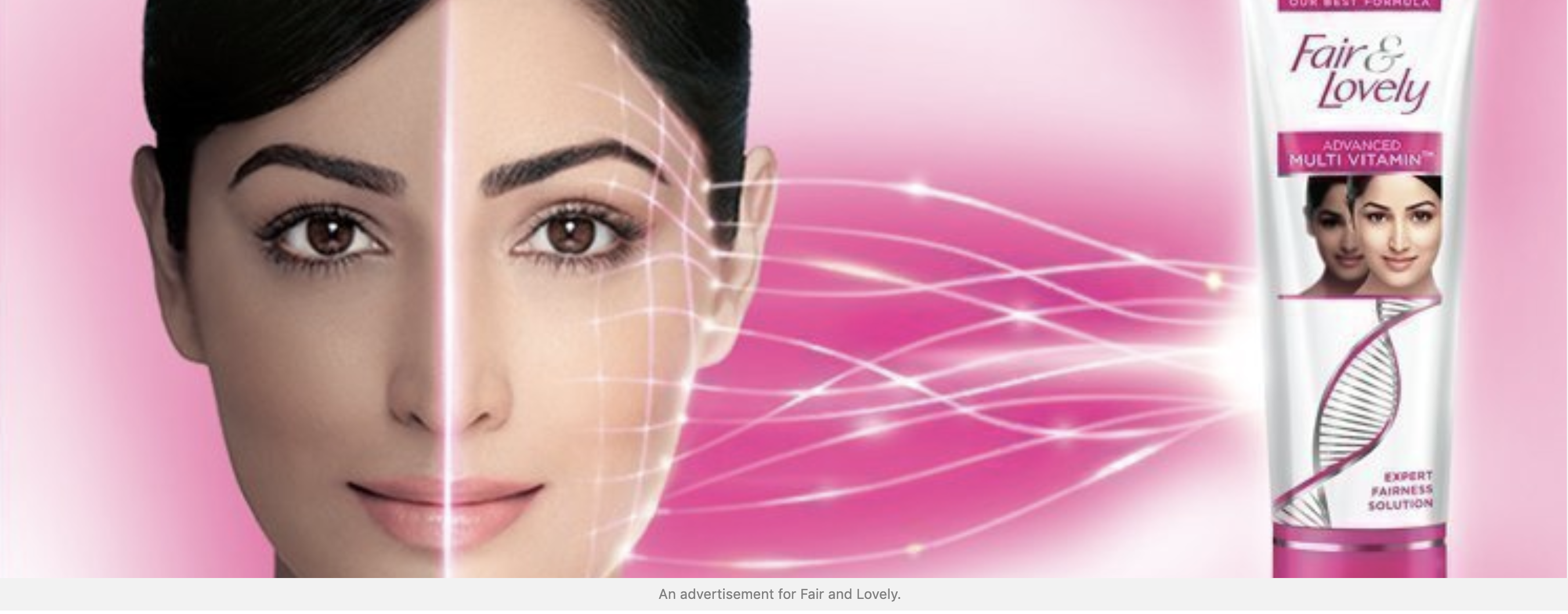

Proof of how all western pictures and standards influence other countries is provided by a study conducted in the Nineties by Anne Becker, an anthropologist from the Harvard Medical School. For centuries, women in Fiji had and cherished a soft, curvy female body, that for them was a symbol of wellbeing and health. This all changed in 1995, when TV first landed in the country, and with it European and American shows (like Beverly Hills 90210 and Baywatch). Becker interviewed a group of girls 3 weeks after TV was introduced in Fiji—no one showed to have any issues with their appearance—Then, she re-interviewed them 3 years later, and discovered that 74% girls felt fat, while 11% of them had developed bulimia.
Another thing to consider is that often on magazines and advertisements the skin of black celebrities is lightened in postproduction, like we can clearly see from the pictures below.

Last but not least often advertisements send subliminal messages…

I don’t know about you but, beside feeling disgusted by all this, I’m also pretty pissed off. How is it possible that they are distorting our perception of reality to the point that we feel we need to look like a toxic beauty standard that has nothing to do with us? What the fuck are we allowing them to do to us?!
SEX, SEX, SEX – THE ETERNAL WOMAN-OBJECT
Objectification is the process of representing and treating a person as a sexual object at the service of someone else’s sexual pleasure
—Caroline Heldman
Until about 20 years ago, pornography and pop culture were two completely different worlds, today though the line between them is often blurred…

Sex sells, we all know that, and those who create advertisements know this even better: by striking consumers in their subconscious and stimulating their sex drive, a shit-ton of money is guaranteed. In fact to sell a beer, a naked woman with pre-orgasm face appears magically in the ad!
Women’s sexual objectification is a constant plague in our society, and we do not see it only in magazines and in ads: how many times does it happen that in a movie, completely out of context and in a way that doesn’t have much to do with the plot, the actress is either naked or sexualized? In how many video-games do female characters wear super sexy and revealing clothes, with rigorously huge boobs in sight? And what about music videos where female singers or dancers dancing in male singers’ videos are either half-naked or wear hyper-sexualised outfits? What about showgirls used merely as decoration elements in shoes? (this happens a lot in Italy)
What is the message we interiorize?
Before anyone start calling me a hysterical feminist, try staring at each picture for 30 seconds. Please look at them well, one by one…
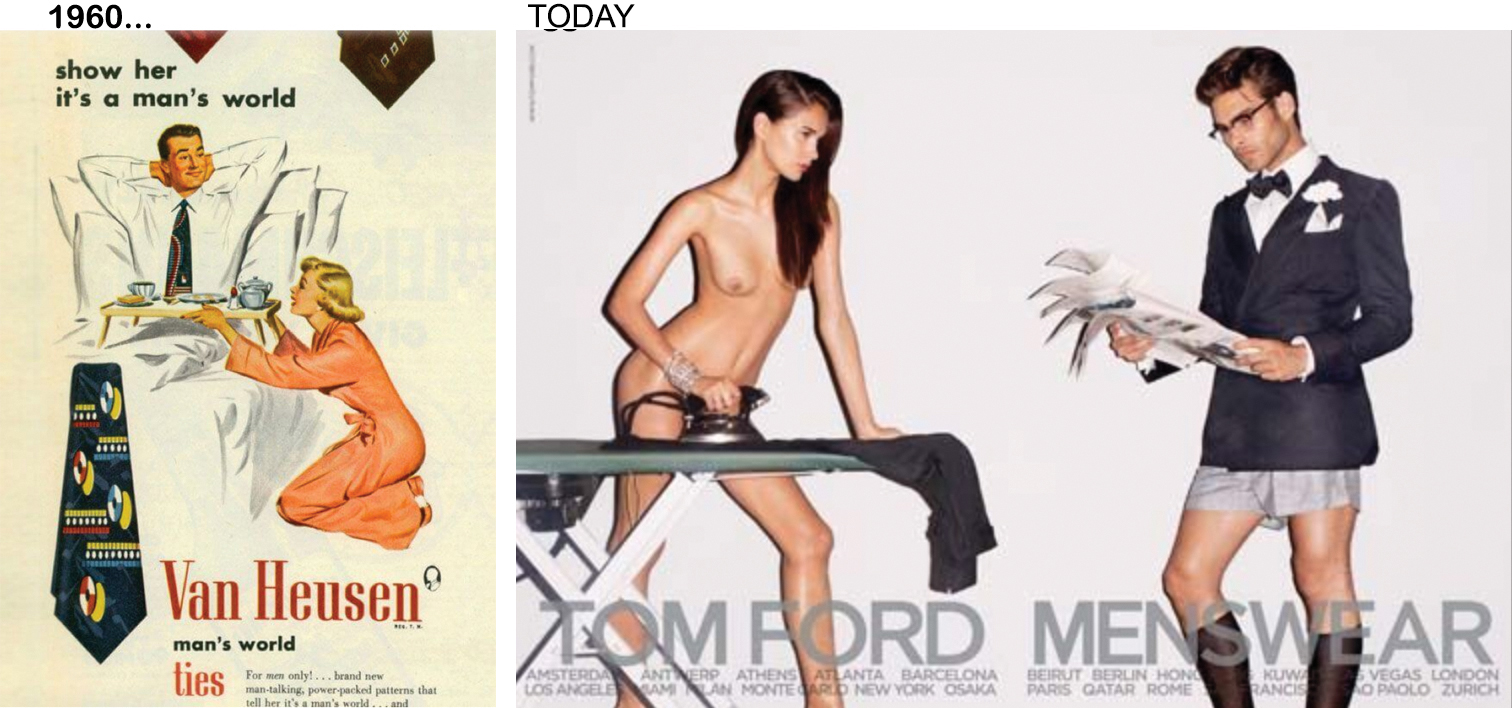



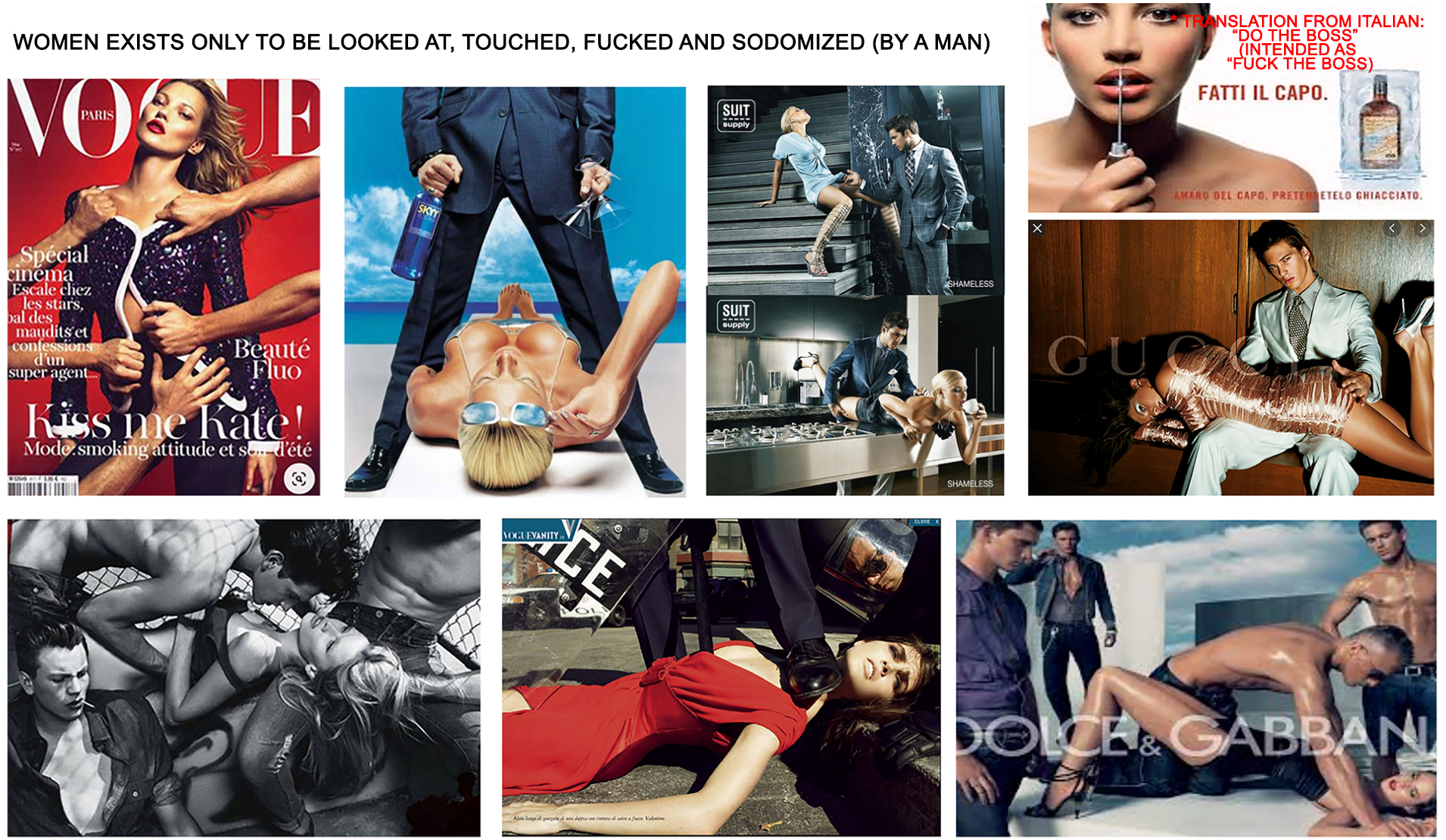
To parafrase the #WomenNotObjects campaign: which woman would not like to have a slice of her ass cut off? Or giving blowjobs to a sandwiches or a popsicle? Or to be squirted in the face with weird stuff? Or, even better, to be sodomized by a group of greasy alpha-men? (it’s called gang-rape FYI). Let’s end this shit-show in style: how could we forget the ads of the American fast-food chain Carls Jr that seem to scream: “Prostitute yourself for a burger!” or maybe “Fuck a burger”, I don’t know guys, you judge!
Oh last one, I couldn’t leave out this masterpiece:
Do you feel nauseous? Me too! This kind of representation not only contributes to perpetuating gender inequality but between the lines, very, very subtly, incites to violence against women. Like Jean Kilbourne often explains in her talks these pictures are not causing a violent behavior directly , but they definitely contribute to normalizing it, because the only message conveyed through it is “women are object, do whatever you want with it”.
And there you go with catcalling, unwanted attention, verbal harassing and everything else that might happen. Many of you may think “You’re exaggerating”. No! Let’s keep in mind that women walk on the street, they walk it in a different world than men. A world where they could be harassed, attacked or raped, and when they are objectified, this possibility increases.
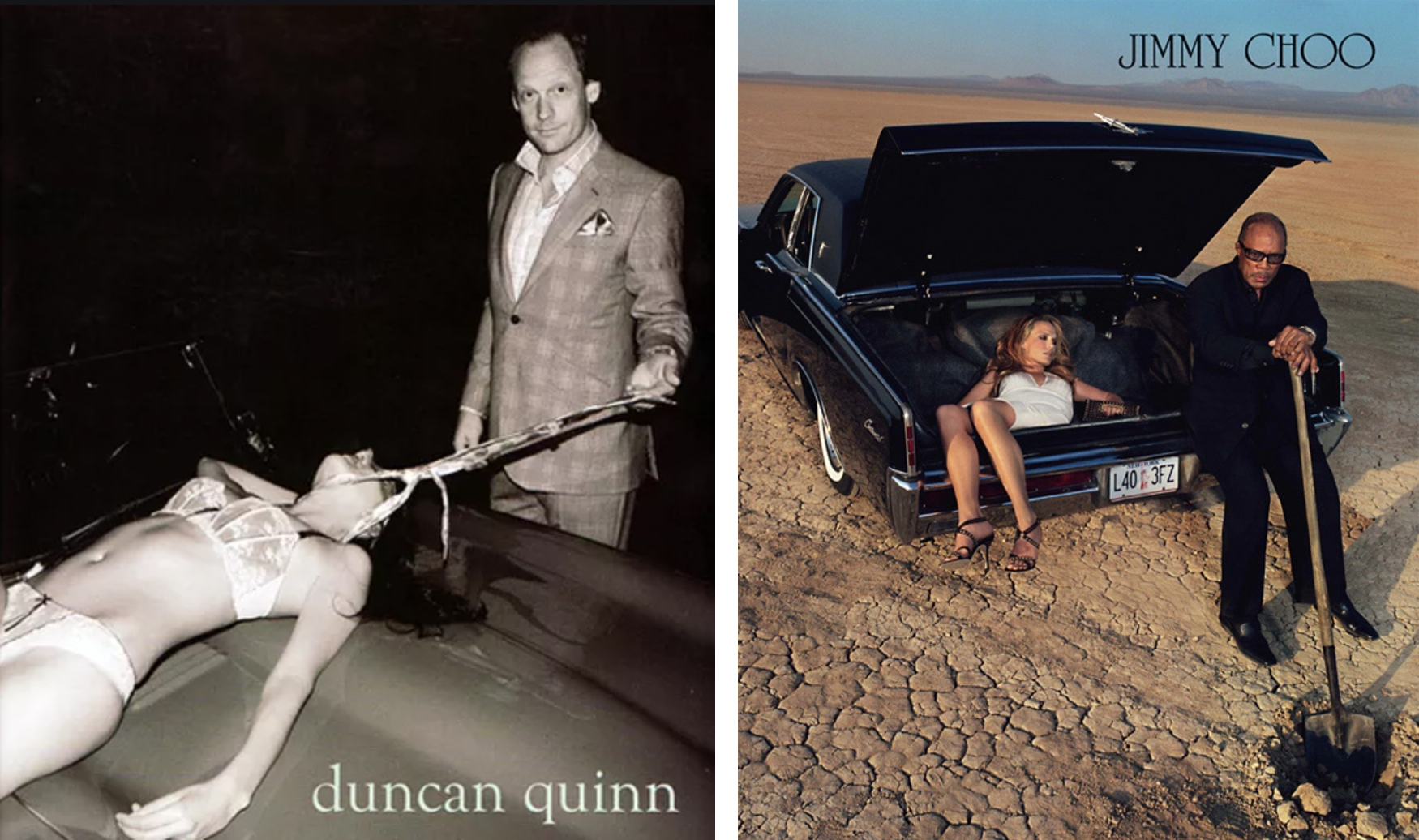
It’s clear, isn’t it? The female body gets continuously exploited to sell something– from beauty products to food to ideals—Women get basically dehumanized, represented not as a thinking human being, equipped with capabilities, talent, emotions, feelings, desires, dreams and objectives; but as sexual objects—always available—ornament, decoration; even submissive or, even worse, just a piece of meat (pieces of a body: a face, a body, two boobs, legs, and each piece has a different value). Not very women empowering right?!
[*let’s keep in mind that empowerment comes when you are the subject acting and not an object that’s constantly observed, looked at, used. There is no power in being an object, regardless of how sexy the object might be. If we want to really reach equality and to be recognized with the same exact value given to men, objectification—meaning giving value to the body and not to the person—individual or collective, in any form, is a huge obstacle to equality. Also, since words matter, let’s remember that the meaning of ‘sexy’ is ‘sexually attracting or exciting’.]
However, most of the ads displayed above are meant for women. You will ask yourselves: what’s the point to objectify a woman to sell a product to women themselves? Actually, this makes a lot of sense, because who creates that type of ads—usually men—want to have three very specific effects:
1 – that you (woman) look at the woman in the photo and start comparing your body to hers (feeling like shit as a direct consequence)
2- that you (woman) start thinking that your value depends from the attention that your body receives, especially from heterosexual men [this is the foundation of objectification. By doing this, in addition to the pressure of having to be pretty and skinny, you will also start to feel the pressure to be sexy.]
3 – that you (woman) see yourself as a body rather than a complete person.
Bombarding us with hyper-sexualised-women-objects with idealized bodies influences both the way men think that a woman “should be” and the way women see themselves.
This is why many of us—especially younger girls—think that physical appearance is the most important part of their “self”, and that being sexy is a life goal; that way they end up spending most of their money, time and energy trying to getting close to the unreachable standard. And this is where self-objectification starts.
SELFIE-MANIA
“Beauty’ is a currency system like the gold standard. Like any economy, it is determined by politics, and in the modern age in the West is is the last, best belief system that keeps male dominance intact.”
―
Like Lexie and Lindsay Kite (both Ph.D) explain on their website beautyredefined.org (an incredibly useful resource for women of all ages) The problem is not that only some type of bodies are valued, but that women’s bodies are valued more than women themselves. For many, too many girls, being considered attractive is more important than anything else: more than their education, their own health, their own well-being, their desires, their objectives. Being constantly obsessed with your physical appearance—and this affects both who feels beautiful and attractive and who doesn’t—ruins the lives of countless children, girls and women that could have used the mental energy they dedicated to aesthetics to do something important with their lives.
It’s not their fault though. Regardless of how much we believe to be immune to them, advertisements, mass media and social media, do influence our life and our vision of the world.
Self-objectification is one of the consequences of thinking that our body is more important than who you are. It’s a beast, rooted in the female collective conscience. It’s hard to eradicate it, and it’s super difficult to understand when we are self-objectifying, especially if we spend hours scrolling on Instagram or Facebook. Now that our lives are more and more digital, just by scrolling our finger on our smartphone we get bombarded with both the Standard and by those who chase and try to emulate it. [*the fact that many influencers are not models but, in theory, just “normal girls” triggers the illusion that you’re seeing something “true”, but the photos posted by influencers (and their physical appearance) are often not that different from the ones discussed until now) so scrolling makes us feel even worse.]
I’ll risk to sound very, very unpopular with what I am about to say, because I’m going to touch some fragile and shaky buttons of feminism, but I will still say it, at the risk of being crucified as anti-feminist/feminist-radical/nun/frigid/a bitch/enemy of women/and whatever else you might say. [*Disclaimer: I have always had a super peaceful relationship with my sexuality and I have regular healthy sex. Ready?]
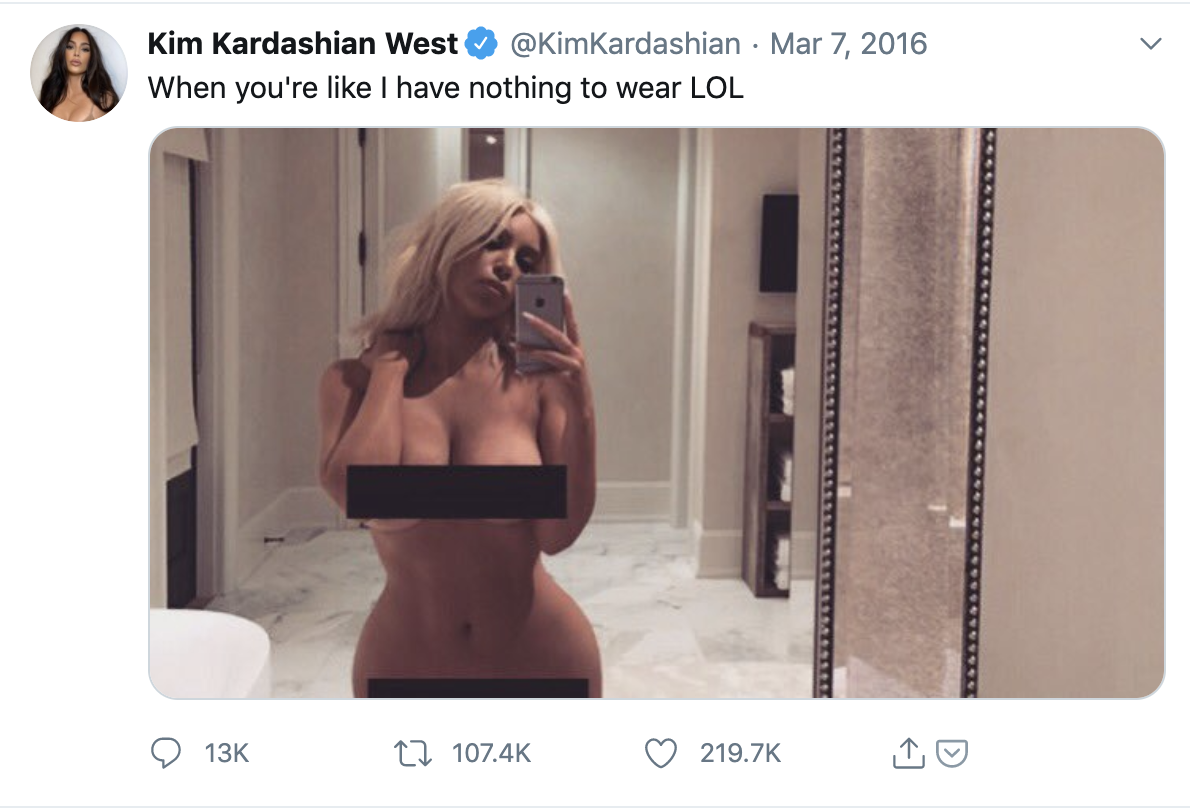
Tweeting photos of your boobs—every reference is absolutely casual—or posting on Instagram selfies and pictures of yourself in sexy poses and with the “fuck me” look on your face is not a revolutionary act against the Patriarchy, it’s not women empowering, it just another side of objectification, that contributes to perpetuating gender inequality. Ok, I said it!
If each and every pixel of your photo—screams “look at me, desire me, take me, fuck me”, that stuff ain’t empowering. It doesn’t empower neither the girl in the photo nor women as a spectrum. That is instead a form of interiorized misogyny, an explicit request to be looked at, validated, rewarded for her body, as a body…and I can assure you , 100%, that the instant validation given by hearts, likes, thumbs ups and comments coming from it will not fill the void of your low self-esteem.
Femininity has nothing to do with our external appearance. As long as our attention will be focused on the body, we will never get rid of our prison made of impossible beauty standards.
There is nothing wrong with taking selfies, or posting photos of yourself, or nudity, or sensuality, or wearing make-up, or shaving your armpits, or wearing whatever you might want to wear; it’s the reason why you do it and your attitude that make the difference between expression and objectification.
I’m not saying all this to act like a moralist, but because Instagram today is so full of galleries featuring teenage girls sharing half-naked selfies with expressions on the verge of soft-porn, and that have the same face of the Russian model that broke me that day on set in NYC. Many of us had the fortune to have been a teenager—the most vulnerable period of our lives—when social media did not yet exist. We weren’t as bombarded of images as kids are today, yet we fucked up our self-esteem anyway. Imagine how a 14 year-old girl must feel today, when she doesn’t have the necessary mediatic alphabetization she’d need to healthily surf this ocean of idealized and hyper-sexualized images of toxic role-models.
[like some girls in the pictures and videos above, just as a remark, because yes we are free to do whatever we want with our body, of course we are, but please let’s avoid saying that we do it in the name of women empowerment if the truth is different. After watching all the videos and images above, considering that many of those women are considered as role-models by millions of little girls, fuck being politically correct at all costs!].

These young girls are doomed to a life of eternal dissatisfaction and obsession with their physical appearance if nothing is done to avoid this.
According to Caroline Heldman—a scholar and researcher of the Los Angeles Occidental College—as she explains in her TEDx talk “The sexy lie”, these are the consequences of self-objectification:
– depression
– usual body-monitoring
– body-shaming
– decrease in cognitive capacities
– sexual dysfunctions
– low self-esteem
– lower grades at school
– lower political efficiency
– competition among women.
Who lets their life be monopolized by “beauty” and sex-appeal is neither stupid nor superficial, but only a victim of the capitalist and consumer system, that was thought and created only for a male perspective; it’s a system that destroys women, making them feel wrong, constantly observed and therefore “in duty” to show themselves in a certain way; making them feel like a body, a body that has to be sexually arousing.
But we aren’t bodies made to be looked at, we are womenb, women that have a lot more to give to the world that being sexy.
Naomi Wolf, in her book The Beauty Myth says: “A woman wins by giving herself and other women permission —to eat; to be sexual; to age; to wear overalls, a paste tiara, a Balenciaga gown, a second-hand opera cloak, or combat boots; to cover up or to go practically naked; to do whatever we choose in following — or ignoring — our own aesthetic. A woman wins when she feels that what each woman does with her own body—unforced, uncoerced—is her own business.”.
I truly wish we lived in a world that reflects these words, but how difficult is it to even just imagine that world, considering the society we live in?
WHAT ABOUT MEN?
Men too are subject to the weight of a representation that’s pretty far from reality—athletic body, sculpted abs, muscly arms and legs, shaved chest– and are sometimes objectified in advertisements, though much less and in a different way than women. Men though are never represented as passive or submissive, actually quite the opposite: the way they are represented strengthens the gender stereotypes according to which there is “a way” to be a man. “You have to be strong, dominant, arrogant; don’t you dare crying!”, beliefs that spread an idea of toxic virility that hurts everyone (women and men).

Over the past years, apart from shaving creams, deodorants and perfumes, marketers have started to sell on the male market creams anti-wrinkles creams and hair dye to cover the “signs of aging”, but advertisements do not seem to be having the same devastating impact on men’s self-esteem that it has instead on women.
Men are affected by the unrealistic standards too but very few suffer from the “never enough” syndrome that plagues countless women. Why?
Because there is much less mediatic pressure on their physical appearance, and their body is not under constant observation and public scrutiny and judgement…
3- BEAUTY OBSESSION – TO BE OR TO BE LOOKED AT?
Even though the word “aesthetics” exude superficiality from every letter, aesthetics is not an imaginary or futile issue. Each and every woman has to deal with this problem EVERY DAY because of the inputs society throws on us. Thinking that external appearances don’t matter in this world is quite difficult when the society we have around seems to be doing everything to make you believe the opposite.
Society, that often seems disgusted by a normal human body, judges and praises women according to their physical appearance, which is a constant topic of discussion, both private and public. Tabloids keep showing and discussing—and shaming—celebrity’s cellulite or weight gain/loss, not leaving them alone even during pregnancy; magazines often engage in psychological terrorism, reminding us that summer is close and we need to be “beach body ready”; on TV artists, politicians, and hyper-professional journalists are judged or mocked for their muffin tops, for what they wear, for choosing to go out without make-up etc, etc(often from other women). Female actresses on the red carpet are often asked questions on what they are wearing rather than on their performance (and of course men are never reserved the same treatment, in any of the cases mentioned above); then there are a gazzilion articles telling us how to lose weight or how to look good “even when we are home” (like the italian article in the image below). Aren’t we all fed up with this shit?!
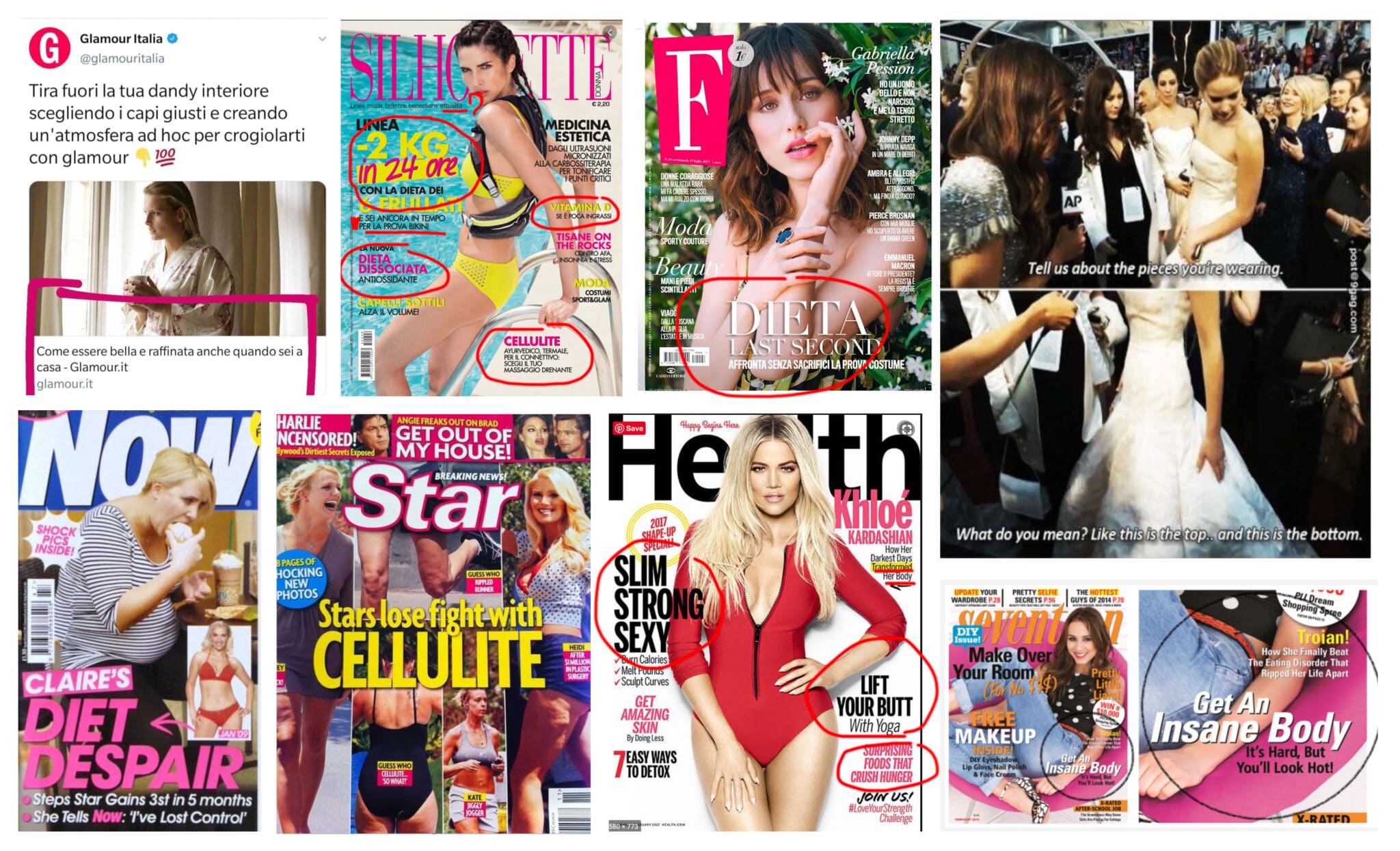
Our appearance is always at the centre of the attention. By doing so, our skills and abilities are moved to the background, diminished, cancelled. This kind of attitude doesn’t only occur on TV or magazines, it gets even worse on social media—that have become a minefield of hatred and verbal-incontinence—where under photos of celebrities and influencers people—sadly, many of them are women—go nuts with comments filled with spite, judgement, mockery and insults towards their appearance.
This phenomenon is called body-shaming, mocking or criticizing someone’s physical appearance. It’s an apparently harmless practice but it can have devastating consequences for some people, among which depression.
The only way to get rid of body-shaming though is to eradicate its roots, by changing the collective idea that our body and appearance is important. I don’t know about you guys, but I’m sick and tired or seeing these things, disgusted by the ongoing system, fed up of seeing women suffering. When are we going to start considering all this unacceptable?
OUR BODY, OUR ENEMY – BODY SHAMING? BODY MONITORING? BODY POSITIVE?
If the world around us keeps focusing on physical appearance, it’s inevitable that we start doing the same. We ourselves become the observers of our body, it’s like having a mirror in our head that makes us think about how other people see us. We’re walking on the street and we adjust our dress, we fix our hair while we’re talking to somebody—I do it constantly, especially while I post stories on Instagram—we are at a meeting and we keep thinking whether our crossed legs show our cellulite, we go to the beach and hold in our belly and, the worst of the worst, we are having sex and instead of focusing on what we feel we get paranoid on how our partner is seeing us right now… does that sound familiar? This is called body-monitoring and every woman does it. According to Caroline Heldman’s research, quoted above, on average women do it every 30 seconds.
Deep in our subconscious, a part of us is always controlling our appearance. The images described until now trigger our inner mirror: a look at an advertising billboard or at a magazine’s cover, a scroll on Instagram, but also a comment—doesn’t matter if positive or negative—on our or someone else’s appearance draws our mind back to our body. And when we think about the body, the mind gets distracted: it becomes hard to focus, to be motivated and efficient, to hear our inner voice, to listen to ourselves, and that way we get more and more disconnected from our inner self, the place where our real strength and worth reside. Basically, doing body-monitoring is an exhausting and limiting process that uses up much of our energy—energy that could be used for far more important things—and, when we monitor ourselves, inevitably we end up judging ourselves, often ruthlessly.
The relationship between “body-esteem” and self-esteem is tightly intertwined. If we don’t like our body, our self-esteem shakes, sometimes it collapses completely; and low self-esteem is a threat to mental and physical health. It prevents us from doing lots of things: from giving up going out—or going to a work meeting, or to school—to not making your voice heard, to not being able to pursue your goals and dreams.
As our concept of beauty comes from the idealized standard chosen by the society, a healthy and pleasing relationship with our body often becomes utopia. Cause in the mirror we don’t see our own reflection, but an image distorted by all the external inputs absorbed during our lives. Sometimes we see an enemy in there, a body to fight; and we start to body-shaming ourselves, feeling shame for our own body—or parts of it—insulting it, talking shit about it with our friends… and when you hate your body it’s hard to take care of it.
body often becomes utopia. Cause in the mirror we don’t see our own reflection, but an image distorted by all the external inputs absorbed during our lives. Sometimes we see an enemy in there, a body to fight; and we start to body-shaming ourselves, feeling shame for our own body—or parts of it—insulting it, talking shit about it with our friends… and when you hate your body it’s hard to take care of it.
This is exactly why the Body Positive Movement was created. The movement aimed to teach people—especially women—to learn to accept themselves. The message launched by the movement was roughly this: “It’s wrong to suffer because of your appearance. It doesn’t metter if you’re fat, skinny, tall, short, with muffin tops, without, with crooked teeth, freckles, big or small breasts, etc. etc; you are ok just the way you are”.
However, despite the noble cause and the positive message the movement failed, because if learning to accept yourself was that easy, I would not be writing this article right now…
FATPHOBIA & DIET CULTURE

Let’s say the word out loud: FAT. A word most of us feared, a word we don’t know when it’s ok to use, a word that we instantly perceived as negative, and that silently implies shame. That’s because our society suffers of FATPHOBIA: the fear/disgust/prejudice/discrimination against fat or fat people, but also the fear of getting fat, everyone of us is in one way or another a bit fat-phobic. Because of a horrible mediatic representation—and everything we discussed up until now—fat-phobia has brought us collectively as a society to consider fat people as lazy, greedy, without self control, losers( In movies fat characters are very rarely represented as people in powerful or successful social positions). This though has serious consequences in the way fat people are treated, for-instance it influences how they are treated at work—where maybe a person isn’t hired because there’s a skinnier candidate for the job—or even how they are treated by doctors.
A fat body—and this, again, happens more to women than men—it’s never considered just a body, it’s always associated instead to some sort of message of bad health. That’s one of the reasons that contributed to create the DIET CULTURE, by which thinness and losing weight are the most important values. Obviously magazines jumped on the diet culture train and started bombarding us with articles that told us about miraculous diets and magical pills to lose weight. Obviously behind all this theres a multi-billion industry that makes $72billions per year on our insecurities.
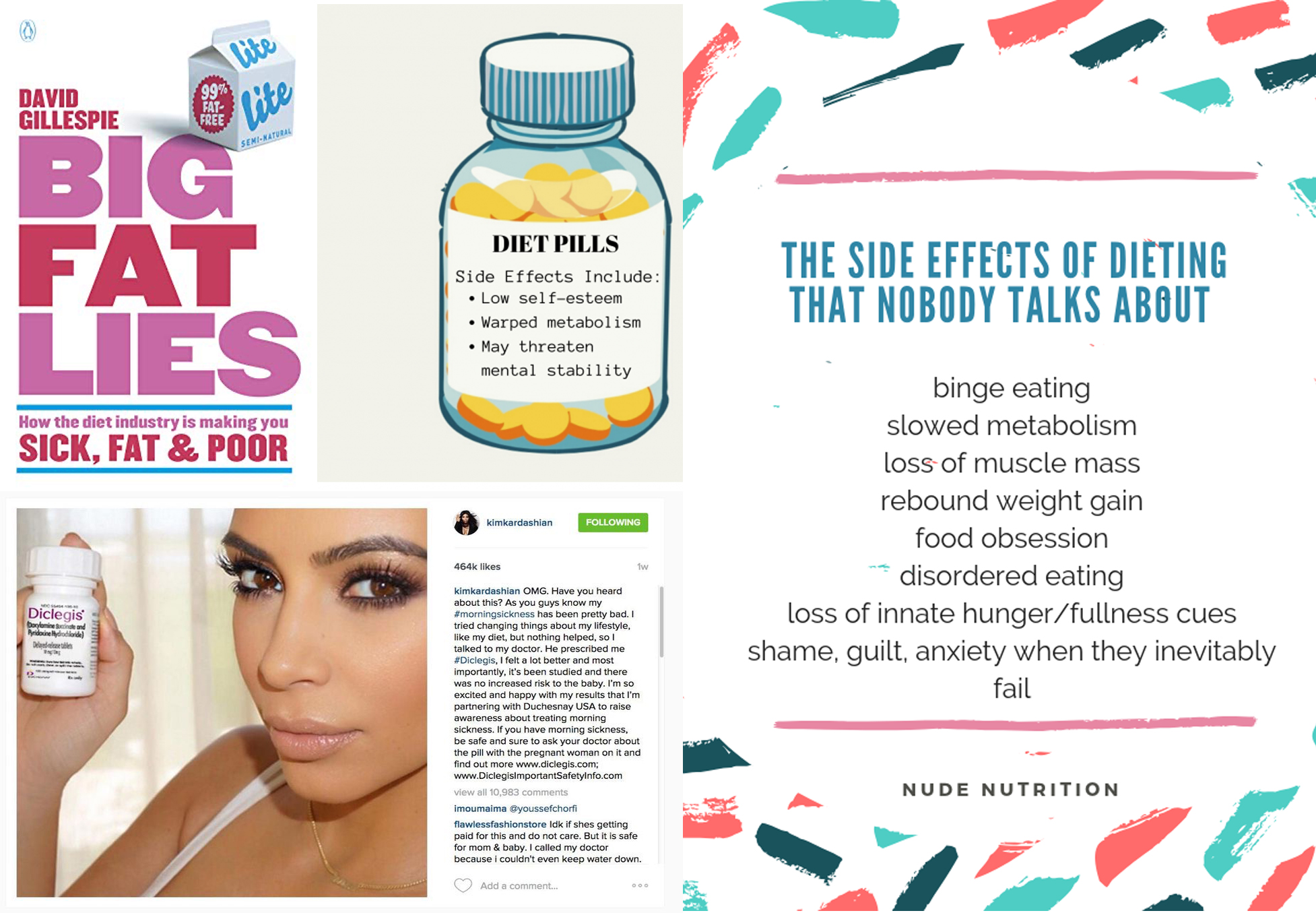
REAL BEAUTY (ACCORDING TO DOVE)
Once understood that most women were unsatisfied with their body, the brand DOVE [that belongs to the multinational company Unilever that, among other brands, also owes Fair & Lovely—the best-selling skin whitening cream in India—and also created AXE’s sexist advertisements] launched its “Real Beauty” campaign in 2004, finally showing and cherishing “normal women”—even though, if you look carefully, you’ll notice that all the women in the ad kind of have a similar body shape, with the classical hourglass figure. Also, let’s just overlook the fact that the campaign was advertising an anti-cellulite product—and then created another video campaign raising the audience’s awareness on the impact of photoshop and unreal beauty standards on our self-esteem. Here too, the purpose was noble and the message was positive: “it’s wrong to suffer for your body. Each body is beautiful as it is” and “this is real beauty: normal women”. Basically, what DOVE did is that same that a friend would do when we confess that we feel ugly, she told us “oh shut up, you’re gorgeous!” ,but when a friend tells us that, rarely it makes us feel better, often we don’t even believe those words.
In fact, 14 years have passed since that campaign, and women are still very unsatisfied with their body. The problem has not been fixed but DOVE has doubled its sales.

The message of DOVE and on the Body Positive Movement is still about women’s body and external appearance though and, year by year, it all shrank to a matter of beauty—from which marketers profited a lot, almost twisting the message—mostly focused on size, forgetting about other factors that would truly promote diversity and inclusion.
However, the biggest issue and the reason why these attempts to body positivity failed is that the key message that people received was this: “Suffering for your physical appearance is wrong”. But, suffering for your physical appearance is unfair, not wrong.
By doing so, a person that is already suffering because of the dissatisfaction about their body, will also develop a sense of guilt, and she will feel even more lacking, even more “never enough”; she will find herself thinking “why can’t I like myself? What is wrong in me?” and her self-esteem will get even lower.
Then, if we miraculously manage to like ourselves the way we are, the world will send us mixed messages: if you don’t care about your body you don’t love yourself; if you care about it you’re self-centered; if you suffer because you don’t like yourself get over it and like yourself; if you like yourself you’re full of yourself… there’s no way to win at this game. Don’t you ever feel like screaming a big huge “Fuck off” to everyone and everything?!
The road toward acceptation takes time, lots of willpower and much, much work on yourself. Before learning how to love ourselves it’s necessary to understand that our value and our skills do not depend, and have nothing to do with our physical appearance. Then, we have to eradicate the idea that we have to reach that fucking unreachable standard in order to like ourselves.
The path towards self-love and feeling whole is long and insidious, and not all women make it, and it’s ok to not always make it, as long as there is the willingness and stubbornness and resilience to continue to wanting to feel good.
The subtitle to this article is “Why we cannot love ourselves as we are”, not “how to love ourselves as we are”, for this reason: there is no magic formula, every path is unique and unrepeatable.
I didn’t win the fight against the image in the mirror, I simply stopped fighting it. How? I made friends with the girl I saw reflected in it and then I broke the mirror…
4- CHANGING TH NARRATIVES & BREAKING THE MIRROR
After that day on set in NYC, I decided to radically change my life. I wanted to use my work to make women feel good about themselves, not to oppress them, so I left the fashion industry behind and I started to travel the world to photograph and interview women I met on the street asking them what beauty meant for them; a real quest to discover and redefine the meaning of the word itself. I called the project “Quest for Beauty”; it was my way to make up for the damage done to women with my fashion work.

While talking about beauty with women all over the world, I began to radically change my point of view, I started seeing both beauty and of myself in a much different way: this project helped me healing, and step by step I understood that the best way to get rid of that dissatisfaction I felt when I looked in the mirror was to look less at it and look inside myself more.
In order to defeat the beauty regime, it’s not enough to ask the media to better represent us and to renormalize “normal women” —they will never do it—We have to act in a revolutionary way, changing what society values, and, since we are part of society too, together we can change things, or at least we can try to. Now we know that we are being manipulated into hating ourselves and exploited for the profit of companies that literally make billions of dollars out of our insecurities and pain, do we want to keep letting them do it at the expense of our physical and mental health? or do we want to be free to exist as complete persons and not only bodies?
To truly love ourselves and to get rid of unreachable standards, we have to stop giving importance to external appearance, think and talk less about our and other people’s bodies, stop giving value to physical beauty and start to give value to ourselves as people. There are so many little things that we can do to break the chains of “never enough…”
CENSOR YOUR THOUGHTS AND BIT YOUR TONGUE
Stop talking about it, stop thinking about it! Don’t talk about your appearance and weight with others and stop—kindly—those who do it with you. Instead of complimenting a friend for losing weight (no, no, no!) or for their new look, compliment her for something that has to do with an achievement or a quality of hers.
Never tell little girls “you’re so pretty”, try to tell them something that could really be good for her and their self-esteem instead: “You’re so brave, you’re so strong, you’re so smart!”.
Every time you realize you’re thinking a negative thought about your body, block it right away, don’t fall in the self-destructive loop that will start listing all the ways you’re not enough; replace it with a positive thought about your body instead [I know it’s difficult, but make an effort to find it; don’t move from there until you do.]
These are small things that, if done with perseverance, will bring huge results.
BODY-ALLY
Instead of thinking your body as your archenemy, think that it’s only thanks to it that you are alive and you can do everything you do. Every time you catch yourself complaining about your body, think about it and correct yourself. Instead of saying “I hate my huge legs”, change the narrative into “I’m grateful for these legs that bring me where I want to go”. Focus on your inner abilities, skills and qualities, not on your appearance.
MEDIA DIET
Detox from the media that keep perpetuating The Standard. Do not buy magazines that bombard you with toxic images, do not watch programmes where physical appearance is at the centre of attention. Consume only healthy media that benefit your mental health, not destroy it.
CLEAN YOUR FEED – UNFOLLOW. MUTE. DELETE. REPEAT.
What we pay attention to determines the quality of our lives. If your feed is full of perfect photos of perfect models and women that make you compare your body to theirs—and make you feel like shit—and instigate in you envy or other negative feelings… stop following them! Try to follow people for what they do, for what they say, but not for their external appearance.
Clean your feed, check your following list. Follow normal people, that do normal things, you’ll see a huge change in your mood and your self-esteem!
Every time you scroll on Instagram, ask yourself: “how does this person’s photos make me feel? Does following this person add any value to my life?” and if the answer is no, unfollow them immediately.
BOYCOTT, BE POLITICAL
Boycott all those brands that sexism, stereotypes or images that triggers the “never enough” feeling. Deciding where to spend your money is a political choice. Keep in mind that without us, those brands cannot survive.
MAKE YOUR VOICE HEARD – BE OUTRAGED, GET ANGRY, DENOUNCE, REPORT
If you hear someone engaging in body-shaming, confront them; if you see a harmful or toxic advertising campaign on a magazine or on Instagram report it, make a story expressing your indignation, write to the company or to the magazine. You don’t need to have 1 million followers to spread the message, today you can set off a shitstorm with just one click.
ASK FOR HELP
Sometimes the only way to defeat the damn “never enough” is to ask for help to a professional, psychologists, psychotherapists, they can be a great resources to help us in the path towards self-acceptance and self-love
TOGETHER – A FEMININE WAY OF SEEING
Competition among women is real. The common stereotype is to think that women are competitive with each other by nature, that they were born that way…bullshit! It’s not our nature to be competitive, it’s the consequence of objectification and of looking at ouselves through the male-gaze. Self-objectifying ourselves—meaning thinking that our values depends from the attentions our body gets from men—and posting pictures of ourselves with the “fuck me look” is what creates the competition. Thinking—as a woman—that other women are your enemies that you have to compete against is a form of interiorized-misogyny.
We will never win this fight by fighting by ourselves or competing against one another and judging each other, but only by supporting each other. Like Naomi Wolf’s said: “The toughest but most necessary change will come not from men or from the media, but from women, in the way we see and behave toward other women”. In order to change the narrative, we need to change the way we see things: let’s try to see them with women’s eyes rather than with the usual male-gaze that was imposed to us until today. Before posting a selfie or a photo with a “fuck me” pose let’s ask ourselves “Why am I doing this? What is the message I want to send? Am I doing this for myself? Am I doing it because I want to or because I was conditioned to do so?”
Let’s self-represent. Let’s think as women. Let’s treat each other as friends, sister, traveling companions. Sisterhood is one of the most beautiful words in the dictionary.
And please please please, let’s always remember that perfection is and always will be a pile of shit served to you to make you unhappy. Perfection doesn’t exists and aiming to achieve it will ruin your life.
After owning and applying each of the points described above, my relationship with my body and my appearance has improved by 200%. I no longer follow any model on instagram, I no longer buy the magazines for which I once used to dream to work for, I have no TV at home; I no longer want to get a nose-job (actually I’m super grateful I didn’t get one), I barely use make up; I spend a really short time in front of the mirror and invest very little money in beauty products; I still have a couple fixations—such as hair, last year I went to the hairdresser’s to have my hair trimmed and he cut like 20cm and I spent a whole week crying!—and sometimes I’m still afraid of jumping on the scale, but today, whenever I see the girl in the mirror I always smile to her, I learnt to love her for who she is.
It’s been 5 years since I started Quest for Beauty. I talked to hundreds of women of different sizes, ages and ethnicities all over Europe, America, Africa and Asia; to all women that I interviewed I asked these 5 questions:
– What is beauty?
– in your opinion, what is the most beautiful thing in the world?
– What makes a woman beautiful?
– What makes a woman not beautiful?
– Do you feel beautiful?
98% of the answers that I received have nothing to do with physical appearance, but are related to abstract notions. Answers to the question “What is beauty?” vary: “it’s an emotion”, “it’s a child’s laugh”, “it’s what I feel when I look at a sunset”, “Beauty is God”. To the question “what makes a woman beautiful?” the most common answers are: kindness, empathy, self-confidence. Isn’t this beautiful?!
If most women all over the world don’t think that beauty is a matter of aesthetics, then why do we let the society tell us the opposite? Why do we allow the media to dictate what beauty, femininity and sexuality should be for us? Do we want to keep living in this kind society? or do we want to be free?
I want to live in a society where no child, girl or woman should ever feel like shit only because they didn’t win a genetic lottery. This kind of society is possible. Things can change, the only people that will tell you that it’s impossible to change are those people that have an interest in keeping things the way they are. So let’s change the narrative, let’s change the way women see themselves starting from the way we see ourselves: we are not bodies, we are human beings.
The real revolution always starts from inside you!
Do your part!
Love,
—S
IF YOU FOUND THIS ARTICLE USEFUL PLEASE SHARE IT ON SOCIAL MEDIA. POST A STORY ON INSTAGRAM TAGGING ME @saramelotti_ ON MY PROFILE YOU’LL FIND A VIDEO VERSION
DO YOU WANT TO CONTRIBUIRE?
-Share this article with the people you know
-Post a picture on instagram with the #alwaysenough and in the caption tell the world about how the “never enough” impacted your life.
FOR MORE INFORMATION:
THE ILLUSIONISTS by Elena Rossini
“The Sexy Lie” by Caroline Heldman
“The dangerous ways ads see women” by Jean Kilbourne
Se vuoi ricevere il PDF con link, risorse e approfondimenti utili iscriviti alla mia newsletter qui
Thanks to Sara Scardavilli for helping with the translation

 NEVER ENOUGH – A No Bullshit Guide to Why We Can’t Like Ourselves The Way We Are
NEVER ENOUGH – A No Bullshit Guide to Why We Can’t Like Ourselves The Way We Are


